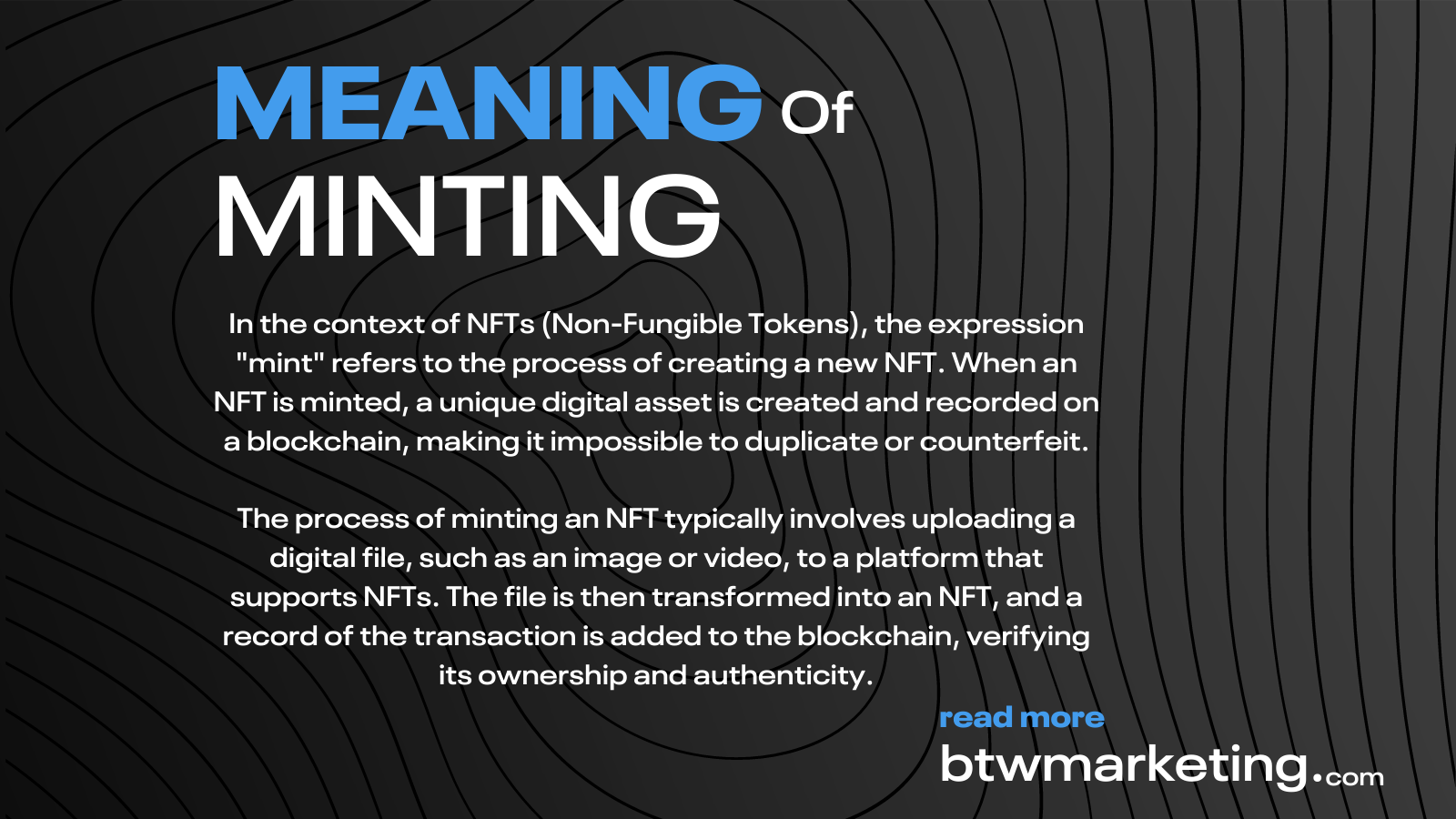In the context of NFTs (Non-Fungible Tokens), the expression "mint" refers to the process of creating a new NFT. When an NFT is minted, a unique digital asset is created and recorded on a blockchain, making it impossible to duplicate or counterfeit.
The process of minting an NFT typically involves uploading a digital file, such as an image or video, to a platform that supports NFTs. The file is then transformed into an NFT, and a record of the transaction is added to the blockchain, verifying its ownership and authenticity. Minting often involves paying a fee known as "gas" to cover the cost of processing the transaction on the blockchain.
Once an NFT is minted, it can be bought, sold, or traded like any other digital asset. The ownership of an NFT is verified by the blockchain, and the unique identifier assigned to each NFT ensures that it is one-of-a-kind and cannot be duplicated or replicated.

Minting on Solana
Minting on Solana is the process of creating new NFTs on the Solana blockchain. Solana is a high-performance blockchain designed for fast and inexpensive transactions, making it an attractive platform for creating and trading NFTs.
To mint an NFT on Solana, the first step is to create the digital asset that will be turned into an NFT. This could be anything from a digital artwork to a video or audio recording. Once the digital asset is created, it needs to be uploaded to a platform that supports NFTs on the Solana blockchain.
There are several platforms that allow users to mint NFTs on Solana, including Solible, Digital Eyes, and Metaplex. These platforms use smart contracts, which are self-executing contracts that automate the process of minting and trading NFTs.
To mint an NFT on Solana, the user typically needs to pay a fee known as a "minting fee." This fee covers the cost of processing the transaction on the blockchain and can vary depending on the platform used. The fee is paid in SOL, the native cryptocurrency of the Solana blockchain.
Once the NFT is minted, it is recorded on the Solana blockchain and given a unique identifier known as a "token ID." The token ID serves as proof of ownership and authenticity and can be used to track the NFT's ownership and transaction history on the blockchain.
Minting on Solana offers several advantages over other blockchain platforms, including fast transaction times, low fees, and a growing ecosystem of NFT marketplaces and platforms. As the popularity of NFTs continues to grow, Solana is likely to become an increasingly important platform for creating and trading these unique digital assets.
Minting on Ethereum
Minting on Ethereum is the process of creating new NFTs on the Ethereum blockchain. Ethereum is one of the most popular blockchain platforms for creating and trading NFTs due to its robust ecosystem and wide range of development tools.
To mint an NFT on Ethereum, the first step is to create the digital asset that will be turned into an NFT. This could be anything from a digital artwork to a video or audio recording. Once the digital asset is created, it needs to be uploaded to a platform that supports NFTs on the Ethereum blockchain.
There are several platforms that allow users to mint NFTs on Ethereum, including OpenSea, Rarible, and SuperRare. These platforms use smart contracts, which are self-executing contracts that automate the process of minting and trading NFTs.
To mint an NFT on Ethereum, the user typically needs to pay a fee known as a "gas fee." This fee covers the cost of processing the transaction on the blockchain and can vary depending on the current network congestion and gas prices. The fee is paid in ether (ETH), the native cryptocurrency of the Ethereum blockchain.
Once the NFT is minted, it is recorded on the Ethereum blockchain and given a unique identifier known as a "token ID." The token ID serves as proof of ownership and authenticity and can be used to track the NFT's ownership and transaction history on the blockchain.
Minting on Ethereum offers several advantages over other blockchain platforms, including a large and established ecosystem of NFT marketplaces and platforms, as well as a high degree of security and decentralization. However, the network congestion and gas fees can be a challenge for some users, especially during times of high demand.
Overall, Ethereum remains one of the most popular and versatile platforms for creating and trading NFTs, and is likely to remain an important player in the NFT space for the foreseeable future.